


Anhydrous chromium(III) sulfate?
When a chromium (VI) or chromium (III) compound is added to concentrated sulphuric acid and heated to a sufficiently high temperature, then finally, an off-white (pale yellow/brown) solid is formed.
Hexavalent chromium compounds first dissolve, giving a red/brown solution of CrO3, but on further heating this decomposes, giving off oxygen gas. The liquid becomes green.
A soluble trivalent chromium salt (not calcined Cr2O3) dissolves in the acid, giving a nice green/blue liquid. On further heating, this liquid becomes turbid and again, a pale yellow/brown precipitate is formed.
The precipitate is not soluble in water, nor in solutions of NaOH of any concentration, not even when the liquid is boiled for some time. The precipitate also is insoluble in concentrated HCl, and it is insoluble in aqua regia.
![]()
Procedure for performing the experiment with (di)chromate
![]() Take a
test tube which certainly can withstand temperatures of 300 ºC or something like
that. Put some solid potassium (di)chromate or sodium (di)chromate in the test
tube and then add 2 ml of concentrated sulphuric acid (95%). Use good quality
reagents.
Take a
test tube which certainly can withstand temperatures of 300 ºC or something like
that. Put some solid potassium (di)chromate or sodium (di)chromate in the test
tube and then add 2 ml of concentrated sulphuric acid (95%). Use good quality
reagents.
![]() Heat the
contents of the test tube. Quickly, the chromate or dichromate dissolves, giving
a dark red/brown solution. This color is due to dissolved CrO3.
Heat the
contents of the test tube. Quickly, the chromate or dichromate dissolves, giving
a dark red/brown solution. This color is due to dissolved CrO3.
![]() Continue
heating quite strongly. When the acid starts to fume somewhat, evolution of a
colorless gas begins. The solution first becomes very dark, almost black, but on
further heating, the color of the solution shifts to green. The dark color is
due to mixing of red/brown and green. After some time, the generation of the
bubbles ceases again, all CrO3 has decomposed and only trivalent
chromium remains in solution. At this point, the liquid is green.
Continue
heating quite strongly. When the acid starts to fume somewhat, evolution of a
colorless gas begins. The solution first becomes very dark, almost black, but on
further heating, the color of the solution shifts to green. The dark color is
due to mixing of red/brown and green. After some time, the generation of the
bubbles ceases again, all CrO3 has decomposed and only trivalent
chromium remains in solution. At this point, the liquid is green.
![]() At this
point, the liquid also turns turbid. On continued heating, the liquid becomes
really milky. Now the acid is very hot and is fuming strongly.
At this
point, the liquid also turns turbid. On continued heating, the liquid becomes
really milky. Now the acid is very hot and is fuming strongly.
![]() Let the
liquid cool down and then carefully add 10 times its volume of water and
swirl/shake in order to mix the acid and water. Then let settle for a few hours.
After this, an off-white precipitate is obtained, under a green liquid.
Let the
liquid cool down and then carefully add 10 times its volume of water and
swirl/shake in order to mix the acid and water. Then let settle for a few hours.
After this, an off-white precipitate is obtained, under a green liquid.
So, the liquid goes from red/brown to green and then it becomes turbid.
![]()
Procedure for performing the experiment with chromium(III)
![]() Even
easier is the direct use of chrome alum, or chromium sulfate. Put some solid
chrome alum or chromium(III) sulfate in a test tube and then add 2 ml of
concentrated sulphuric acid (95%). Again, good quality reagents should be used.
Part of the solid dissolves. The solution in the concentrated acid has a
bluish/violet color.
Even
easier is the direct use of chrome alum, or chromium sulfate. Put some solid
chrome alum or chromium(III) sulfate in a test tube and then add 2 ml of
concentrated sulphuric acid (95%). Again, good quality reagents should be used.
Part of the solid dissolves. The solution in the concentrated acid has a
bluish/violet color.
![]() Heat the
contents of the test tube. Quickly, the color of the solution shifts from
bluish/violet to deep bright green. This is due to ligand exchange (water-ligands
are replaced by sulfate ligands). This change of color is almost immediately, it
happens when the solution is only a few tens of degrees warmer than room
temperature.
Heat the
contents of the test tube. Quickly, the color of the solution shifts from
bluish/violet to deep bright green. This is due to ligand exchange (water-ligands
are replaced by sulfate ligands). This change of color is almost immediately, it
happens when the solution is only a few tens of degrees warmer than room
temperature.
![]() Continue
heating. The bright green/blue color changes when the liquid becomes much
hotter. The liquid remains green, but the hue changes from green/blue to
green/brown/yellow. Quickly after this, the liquid becomes turbid.
Continue
heating. The bright green/blue color changes when the liquid becomes much
hotter. The liquid remains green, but the hue changes from green/blue to
green/brown/yellow. Quickly after this, the liquid becomes turbid.
![]() Keep on
heating, such that the acid becomes really hot and white fumes are produced. The
liquid becomes very turbid and remains green.
Keep on
heating, such that the acid becomes really hot and white fumes are produced. The
liquid becomes very turbid and remains green.
![]() Let the
liquid cool down and then carefully add 10 times its volume of water and
swirl/shake in order to mix the acid and water. Then let settle for a few hours.
After this, an off-white precipitate is obtained, under a green liquid.
Let the
liquid cool down and then carefully add 10 times its volume of water and
swirl/shake in order to mix the acid and water. Then let settle for a few hours.
After this, an off-white precipitate is obtained, under a green liquid.
![]()
Final result of experiment, an off-white (pale yellow/brown) precipitate
At the end of both procedures, described above, a test tube with a strongly acidic green solution of a chromium(III) salt is obtained. At the bottom, an off-white precipitate settles. This precipitate does not dissolve in water, not even after multiple days.
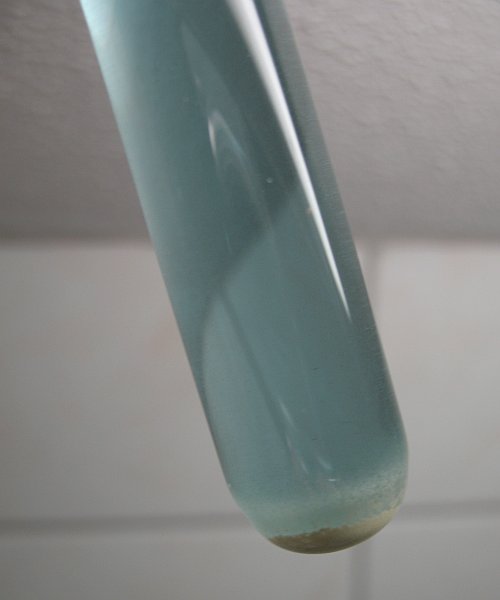
The picture below shows the off-white color of the precipitate, under the green solution.
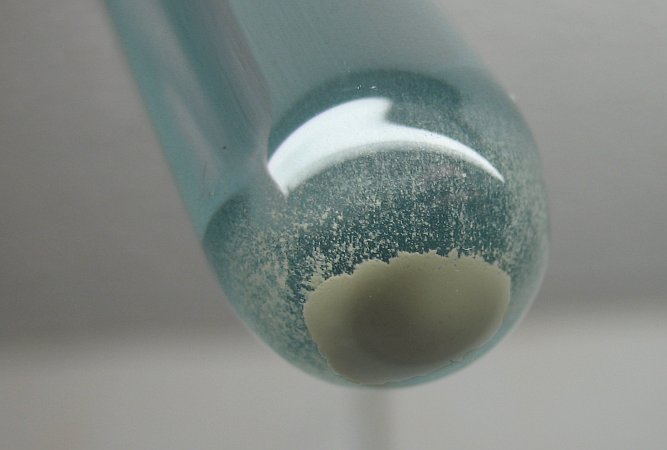
When the green liquid is decanted, and the precipitate is rinsed once with water and then the water is decanted again, then an off-white fine (but quite compact) precipitate remains. The picture below nicely shows the wet precipitate, sticking to the glass.
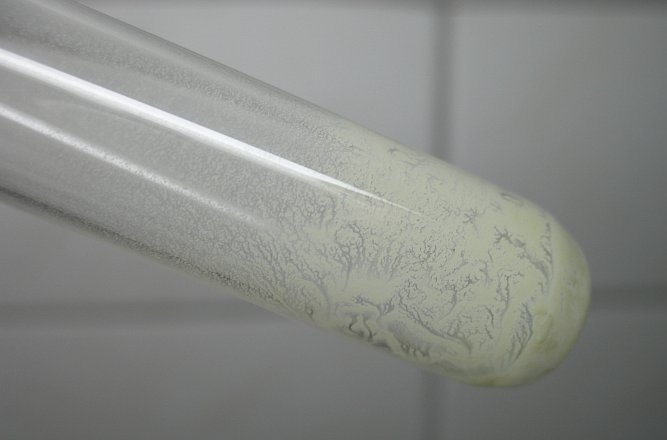
This precipitate does not dissolve in water, nor in acid, nor in a solution of NaOH. This was tested by adding a small amount of water and NaOH to the test tube, with the precipitate sticking to the walls. The NaOH quickly dissolves, but the precipitate does not dissolve. The solution then was boiled gently for a while, but this still does not result in dissolving of the off-white precipitate.
The precipitate really is a chromium(III) compound, and not something, which depends on the presence of potassium ions or sodium ions from the (di)chromate or chrome alum. The precipitate also is formed with chromium(III) sulfate, which does not have any other cations than chromium.
This is a fairly remarkable experiment, because of the formation of a highly insoluble precipitate from a concentrated sulphuric acid solution of a chromium(III) salt. One does not expect insoluble metal salt-precipitates from a strongly acidic liquid.
![]()
What could this off-white precipitate be?
This precipitate is not expected to be chromium(III) hydroxide, because that would react with concentrated sulphuric acid. Another alternative is anhydrous chromium(III)sulfate. This seems more plausible than chromium(III) hydroxide.
In this experiment, an attempt is made to make anhydrous chromium(III) sulfate, by heating the hydrated salt. The true chromium sulfate is used, and not chrome alum, which is a mixed potassium chromium(III) sulfate. This is done in order to exclude all possible interferences, which could result in formation of different compounds, due to the K+ ions.
A small amount of hydrated chromium(III) sulfate was put in a heat-resistant glass beaker.
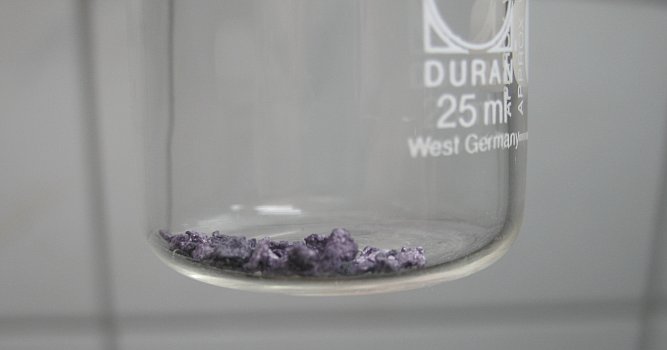
The solid then was heated. The purple solid quickly turns into a green solid (only gentle heating is needed for that). On much stronger heating, the green solid first turns darker, but finally the color shifts to light brown. Also, white fumes are formed.
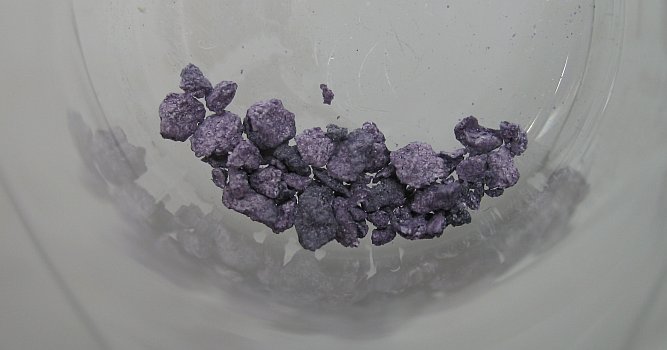
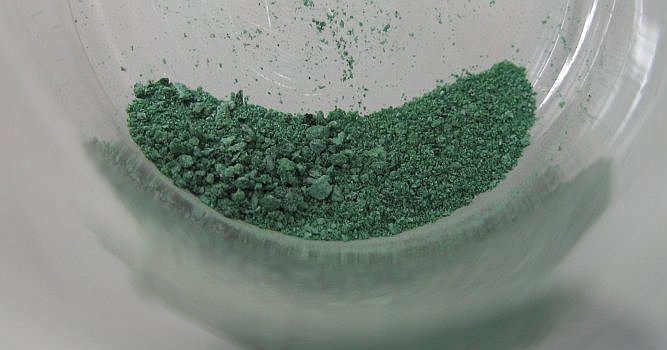
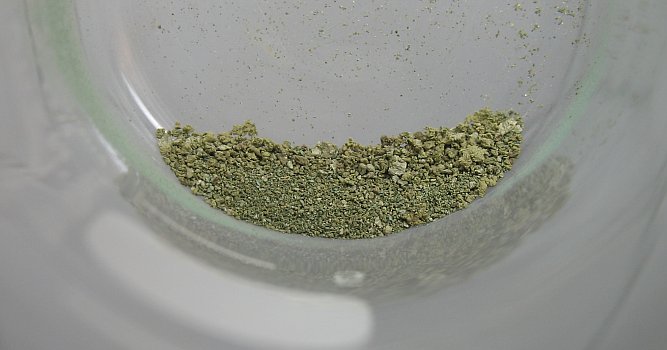
Both the green solid and the brown solid are insoluble in water. The brown material resembles the off-white precipitate from the hot concentrated sulphuric acid.
This experiment of heating hydrated chromium(III) sulfate sadly does not give conclusive results. On stronger heating, a lot of dense white fumes are formed, and the material looses SO3 and maybe H2SO4. So, the light brown material most likely is not anhydrous chromium(III) sulfate, but a basic chromium(III) sulfate. The green material most likely is partially dehydrated chromium(III) sulfate.
Heating of solid chromium(III) sulfate is a nice experiment on its own, but it does not really help in understanding the nature of the fine precipitate, which is formed in the concentrated sulphuric acid.
![]()
What could this off-white precipitate be? -- continued?
More research is needed to obtain information on the off-white precipitate. Is there any material, in which it dissolves? The common acids, aqua regia and concentrated solutions of NaOH and KOH do not dissolve the precipitate. It really is remarkable to obtain such a precipitate from concentrated sulphuric acid.